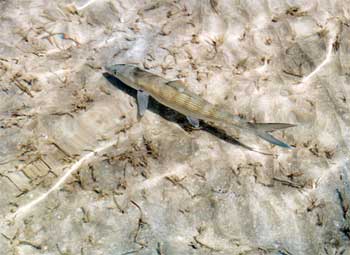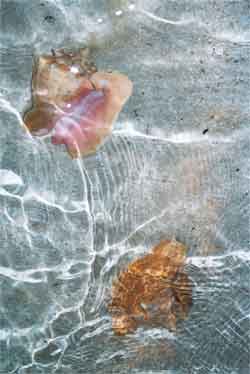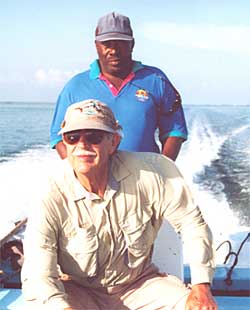“Graveyard Bones”
“BONES DON ea’ now, letta’ mebe,” Graveyard Burrows says.
What he means is: “Bonefish in the Abacos can be very picky; sometimes they’ll take a fly, other times they can’t be tempted. Maybe we’ll get a shot at this school later in the day.”

A bonefish's God-gift is his reflective armor. A shadow is its Achilles heel.
Or something like it. Graveyard Burrows is our guide and he is no talker. I don’t get it exact because I’m busy Fed Ex-ing a cast to the fannies 100 bonefish that vanish into the crystal waters of the eastern edge of The Marls in the Abacos, Bahamas.
Graveyard Burrows is a Scrooge with words; he hoards them, dispenses them in muttered bursts, staccato offerings. This is a bloom of information from an otherwise taciturn 63-year-old Bahamian.
“Der be mo’,” Graveyard grunts. We take this to mean that we will have plenty of opportunities to test our casting mettle and our fish fighting skills.
He’s right, of course. We have lots of shots and we relearn to see these fish. Seeing bones is no easy task. A bonefish’s God-gift is his camouflage, a silvered body reflective and deceptive as any sideshow mirror, designed to shroud him in local color.
Hide in plain sight. That’s the plan.
A bonefish uses his patrimony well. He knows that bottom irregularities and sea grasses, hidden by a sparkly tat of wind ripples, will fool a bonefisher every time. Couple that with a glaring sea, breathless skies, and buck fever, and a bonefish’s odds go up.
Way up.
What a bonefish can’t hide is his movement . . . and his shadow, movements askew. By the end of the first day our tallies are moderate. Fishing partner Lee Hinrichs and I catch six bones each, but we get the picture, we understand the plan.
Day Two
Maybe I had too many local brews last night. Or maybe nine hours in yesterday’s sun caused a foot fault in my synaptic leaps. Either way, the irony of fishing for ‘bones’ with a man named Graveyard doesn’t hit me until we’re well into the 35-minute run from Rickmon’s Bonefish Lodge to Moore’s Island. It’s the second day and the Caribbean is the green color of an old six-cent coke bottle.
The motor and the gentle jostling lull me to sleep.
I’m braced on the bow of Graveyard’s 20-foot “panga,” a spare and sparse craft. Missing are the button-down accouterments of modern flats boat; no comfort seats, no poling platform, no custom coolers, electronics, or graphite pole.

Bottom irregularities and reflective scaling make seeing bonefish difficult — especially from an odd angle.
This is a working boat that pretty much reflects its owner. No $90 fishing shirt here. No up-downer hat. A ratty black ball cap shields Graveyard’s eyes. His concessions to modern-day fly fishing are polarized glasses and Simms wading boots, which he tosses in the back with the oil cans and spare gas.
Graveyard poles his panga from the stern gunwale. Bonefish are easier to see if he’s elevated. And in skinny water. This boat gets shallow.
“How shallow can it get?” I ask.
“We can go ‘til da boot stop,” Graveyard says. His teeth show. He smiles. His answer is glaring, obvious. I feel stupid. He’s gotten me and he likes it.
I like it, too.
Approaching Moore’s Island, the bottom changes to a patchwork of olives, tans, and creams. Grass interspersed with sand blended with something that looks like coconut shavings. The fish will be tough to see here.
“No schoolies on dis flat. See fish hea’, dey bigga’,” Graveyard says of Moore’s Island. Ahead in the grass are the first of hundreds of big starfish, 14 inches point to point. They sport the hey-look-at-me colors of a whore–candy-apple reds, oranges, russets.
Breeze ripples the water. We wait. More starfish. It’s tough finding fish over the grass.
But Graveyard has a plan and he’s poling us to it.
Ahead, the grass ends abruptly and the color shifts from greens and olives to a sandy white. The transition makes a seam, an edge. Fish like edges. The water gets thinner, clearer. The sand accumulates and forms a flat.
This flat takes its color from the pastels of conch shells, a Dreamsicle orange sand the Bahamians call red. It melts away to a creamy/buttery sand, to sandy white, then back to Dreamsicle. Ahead against the bottom we see the broken, ashen silhouettes of sharks patrolling the flats.
“Shoks goo’,” Graveyard says, “Don’ see no shoks, don’ see bones.”
We like sharks. These guys are smaller, two or three feet, unlike the nurse sharks we’ll see mating later in the day.

Abacos bonefish guide Graveyard Burrows runs angler Lee Hinrichs north from Rickmon's Lodge in Southpoint.
“Nussies cootin’,” Graveyard will say when we see a couple of seven footers flopping in ankle deep water 300 feet from our lodge. ‘Cootin’ means boinking, mating.
When the bonefish show on this flat, they show in twos and threes. As promised, they’re bigger. By mid-morning we’ve seen only four or five gangs of bones. We snag a couple of them, but Graveyard doesn’t like the showing and suggests we move on.
We move to a satellite key where the fish are more cooperative, more susceptible to the charms of a nicely presented fly. Here the fish are bigger, too — four and five pounders. We fool a few, but we keep our eyes on a massive thunder anvil to the east. It stabs bolts at the Bahamian seascape, and it’s rushing closer.
Graveyard suggests we run back to ‘The Edge.’
“Mebe dem bones cum bok,” Graveyard says.
I’m happy to run; I don’t trust lightning and, while he doesn’t say, I don’t think Graveyard does either.
Graveyard’s panga steps up three inches on the bow. I fish barefoot, wrap my toes and stand on the balls of my feet to improve my view of ‘The Edge.’ I’m looking at my toes when Graveyard shouts.
“Puh-MIT,” Graveyard says fast, stressing the last syllable. Puh-MIT. Permit!
Permit are a bonus fish in the Abacos. Not that many anglers see them; fewer bring one to the boat. This is a big fish, 25-30 pounds, with an eye the size of a Krystal burger. Crab flies will fool them, but we’re not rigged with crab flies. I get one short shot and a good look broadside before he vanishes.
Then, 15 feet out from the grass, fish movement.
“Nudda puh-MIT,” Graveyard says. This one sees us and scoots off while we play Keystone Kops with our rods.
Behind us the storm mounts. We bolt, but the storm has more horsepower. It surrounds us, engulfs us, blinds us. By the time we punch through, Lee has found out that his rain gear doesn’t work. He doesn’t complain, but he’s taking on lots of water.
Graveyard blinks bare-eyed in the rain. I think he thinks this is a bad day of fishing. Rained out before lunch. Not too many fish seen, only a couple caught. I think this a great day of fishing. I tell him neither Lee nor I fish for numbers, but he knows I’m lying.
Hell, even I know I’m lying. Still, it’s a great day at the park.
Tomorrow I will have a puh-MIT fly on a second rod, I vow silently. Lee shows up with a crab fly the next day, too.
Day Three
I awake early by Bahamian standards. I’m up by 5:30, looking at the sky. Clouds to the north look like they’ll hold. The morning has an edge, a promise. By 6:30 other fly fishers, men and women, have gathered on the seaside deck. It looks good. We’re excited as the last day of school.
The guides show up one by one and hoist the lunch coolers for the 100-yard walk through the sand. Lee carries my stuff and I help Graveyard with the cooler. It’s Father’s Day and Graveyard’s son, Ricardo, shows up to give his dad a big hug.
“Hapy Fadda Dey,” Ricardo says. He’s one of Graveyard’s 12 children. Ricardo is serious about his hug and I can tell he likes his old man.
“You, too,” Graveyard says, laughing. He has 23 grandchildren, eight of which are Ricardo’s.
This day we’re running back to the Marls, to a key farther north.
It’s 9 o’clock by the time we reach our first flat. The key we’re fishing is desolate and ruined, mangrove sticks and roots, a gift from a bad-ass hurricane named Floyd. The wind isn’t a whisper. The bones come, first in small schools, then by the hundreds. Lee and I tied the perfect flies the night before. Our quivers are full.
We begin to catch bones, a few at first, then dozens. The schools keep coming. Lee wades calf deep while I cast on tiptoe from the bow. One fish takes me under Graveyard’s closet-rod pole, then under the motor’s lower unit. I can’t stop him and my rod is bent to the breaking point. This fish is serious about his escape. I scamper down the gunwales and try to change angles, but it’s no use. I make a desperate lunge out of the boat into the water. If this doesn’t work, my rod’s toast.
It works. I jump in time. When I boat this fish, I’m amazed to see that he’s just over three pounds, a real speedster. He’s been working out.
Back on the bow I spot a shadow, a form 70 feet out. It’s a big one. Like the puh-MIT, it moves at us from head on. I look at Graveyard.
“B’cuda” he says. I can tell he’s unsure. We continue to look.
“Tapon,” Graveyard says urgently. “Tink it tapon!” Tarpon!
I give him a good shot, lead him by three or four feet. He closes and keeps moving, unruffled. I fire out another cast. Now he’s parallel to us, 20 feet away. I can see his eye. It sees me back and moves away to find a less crowded aisle of the market.
I figured it for a visual grand slam. Bonefish, permit, tarpon. I tell Graveyard I’m happy just to see these fish.
Again, he knows I’m lying.
Again, so do I.
Rain builds quick and nasty on the third day. The squall takes a bowl shape, swings around to flank us. Graveyard suggests we pull up stakes, maybe stop to fish at Crossing Rock if we beat the rains. So we run, but we can’t hide. The rains overtake us. Lee and I hunker down, he in his drippy slicker, and we punch into the fray.
Fifteen minutes later, nearly a mile from Crossing Rock flats, we find a hole in the clouds and pull up. Graveyard surveys the flats, but doesn’t like what he sees. Two boats.
The flat stretches for miles, but two boats is too many for Graveyard Burrows. Crowds and a gathering grumble from the gunmetal sky cause Graveyard to fire up once more.
It’s a smooth run back and I start to nod off. Twenty minutes into the drone I awake with a start. Graveyard has cut the engine; he wheels the boat.
“Muds,” he says, “Look roun’.”
I see the water has turned cloudy, white really, like a quarter acre of tobacco cloth spread on top. In front of the muds, unseen fish are nosing the bottom, rooting for crabs. The muds are easy to fish, but current, winds and the vagaries of forage make staying with them a problem.
Lee moves forward, fires out a cast. Three strips and he’s into a fine bonefish, six or seven pounds, the biggest yet. We take fish on every cast. Not just bones, either. We get our share of horse-eye jack and blue runners, too, before the clouds catch us. Then the winds cool and the lightning starts popping near us on two sides.
Four times we move to keep up with the mudding school. Thunder pounds us steadily and the rain falls in clumps. Graveyard is getting a lot of use of his old slicker, and he appears resigned to the lightning. The catch stays on and we stay with it, hoping the storm will swing to our southeast.
Then a rogue tongue of blinding electricity bangs next to us. It rattles our ears. Ozone close we say. The hairs prickle on your neck and you know you’ve stayed too long.
“Go now,” Graveyard shouts as he powers up. “De’ bone be dea letta’.” What he means is he is not interested in becoming a fried meal for these fish, that they can be found in more pleasant weather, and perhaps we should call it a day.
I’m getting better; I understand every word.











